The Sustainability of Post-Conflict Development: The Case of Algeria
Abstract
:1. Introduction
1.1. The Confrontation
1.2. Fatalities
1.3. Ideological Clusters and the Role of International Actors
2. The Role of Economic Factors and Natural Resources in the Algerian Civil War
3. The Economic Outlook in Algeria
4. Post-Conflict Development
4.1. Settlement
4.2. Development and Infrastructure
4.3. Agricultural Development
5. Project Development Examples
5.1. West Mitidja Irrigation Project (WMIP)
5.2. Second Rural Employment Project (SREP)
6. Discussion
7. Conclusions
Author Contributions
Funding
Acknowledgments
Conflicts of Interest
References
- Algeria. The Economist, 16 May 2019. Available online: http://country.eiu.com/algeria(accessed on 15 May 2019).
- Schulhofer-Wohl, J. Civil war in Algeria, 1992–Present. In Civil Wars of the World: Major Conflicts Since World War II; DeRouen, K., Uk Heo, U., Eds.; ABC-CLIO: Santa Barbara, CA, USA, 2007; pp. 103–124. [Google Scholar]
- Addi, L. Algeria’s Tragic Contradictions. J. Democr. 1996, 7, 94–107. [Google Scholar] [CrossRef]
- Amirouche, H. Algeria’s Islamist Revolution: The People Versus Democracy? Middle East Policy Council: Oslo, Norway, 1998; Available online: http://www.mepc.org/journal/algerias-islamist-revolution-people-versus-democracy (accessed on 4 October 2018).
- WPF. Algeria: Civil War. 2015. Available online: https://sites.tufts.edu/atrocityendings/2015/08/07/72/ (accessed on 15 May 2019).
- Doyle, M.W.; Sambanis, N. International Peacebuilding: A Theoretical and Quantitative Analysis. Am. Political Sci. Rev. 2000, 94, 779–801. [Google Scholar] [CrossRef]
- Roberts, H. The Battlefield Algeria 1988–2002; Studies in a Broken Polity; Verso: London, UK, 2003. [Google Scholar]
- Wiktorowicz, Q. Centrifugal Tendencies in the Algerian Civil War. Arab Stud. Q. 2001, 23, 65–68. [Google Scholar]
- Stensland, C. Why Did the Algerian Civil War 1989–1999 Descend into What Has Been Called a “Savage War”? Explaining the Nature of the Algerian Civil War. Master’s Thesis, University of Oslo, Oslo, Norway, 2015. Available online: https://www.duo.uio.no/bitstream/handle/10852/45628/Master-thesis-spring-2015.pdf?sequence=1 (accessed on 16 May 2019).
- Olsen, G.R. Europe and the Promotion of Democracy in Post Cold War Africa: How Serious is Europe and for What Reason? Afr. Aff. 1998, 97, 343–367. [Google Scholar] [CrossRef]
- Entelis, J.P. Democracy Denied: America’s Authoritarian Approach towards the Maghreb—Causes & Consequences. In Proceedings of the XVIIIth World Congress of the International Political Science Association, Quebec, QC, Canada, 1–5 August 2000; Available online: http://www.algeria-watch.org/en/articles/1997_2000/paradox_democracy.htm (accessed on 22 November 2018).
- Martinez, L. The Algerian Civil War 1990–1998; Trans. Jonathan Derrick; Columbia University Press: New York, NY, USA, 2000. [Google Scholar]
- Bebbington, A.; Hinojosa, L.; Humphreys-Bebbington, D.; Burneo, M.L.; Warnaars, X. Contention and Ambiguity: Mining and the Possibilities of Development. Dev. Chang. 2008, 39, 887–914. [Google Scholar] [CrossRef] [Green Version]
- Shabafrouz, M. Oil and the Eruption of the Algerian Civil War: A Context-sensitive Analysis of the Ambivalent Impact of Resource Abundance; GIGA Working Papers No. 118; German Institute of Global and Area Studies (GIGA): Hamburg, Germany, 2010; Available online: https://www.econstor.eu/handle/10419/47754 (accessed on 26 April 2018).
- Franco, I.B.; Ali, S. Decentralization, Corporate Community Development and Resource Governance: A Comparative Analysis of Two Mining Regions in Colombia. Extr. Ind. Soc. 2016, 4, 111–119. [Google Scholar] [CrossRef]
- Eklund, L.; Thompson, D. Is Syria really a ‘climate war’? We examined the links between drought, migration and conflict. The Conversation, 21 July 2017. Available online: https://theconversation.com/is-syria-really-a-climate-war-we-examined-the-links-between-drought-migration-and-conflict-80110(accessed on 30 April 2018).
- Mourad, K.A.; Alshihabi, O. Assessment of future Syrian water resources supply and demand by WEAP model. Hydrol. Sci. J. 2015, 61, 393–401. [Google Scholar] [CrossRef]
- Mourad, K.A. Marginal and Virtual Water for Sustainable Water Resources Management in Syria; Report No. 1055; Lund University: Lund, Sweden, 2012. [Google Scholar]
- Collier, P.; Hoeffler, A. Greed and Grievance in Civil War; World Bank: Washington, DC, USA, 2001. [Google Scholar]
- Collier, P.; Hoeffler, A. On economic causes of civil war. Oxf. Econ. Pap. 1998, 50, 563–573. [Google Scholar] [CrossRef]
- Collier, P.; Hoeffler, A. Greed and grievance in civil war. Oxf. Econ. Pap. 2004, 56, 563–595. [Google Scholar] [CrossRef]
- Hill, J.N.C. Challenging the Failed State Thesis: IMF and World Bank Intervention and the Algerian Civil War. Civ. Wars 2009, 11, 39–56. [Google Scholar] [CrossRef]
- Kalyvas, S.N. The Urban Bias in Research on Civil Wars. Secur. Stud. 2004, 13, 160–190. [Google Scholar] [CrossRef]
- Hagelstein, R. Explaining the Violence Pattern of the Algerian Civil War; HiCN Working Paper 43; Households in Conflict Network; The Institute of Development Studies—At the University of Sussex: Falmer, UK, 2008; Available online: http://www.hicn.org/wordpress/wp-content/uploads/2012/06/wp43.pdf (accessed on 1 October 2018).
- Koubi, V.; Spilker, G.; Böhmelt, T.; Bernauer, T. Do Natural Resources Matter for Interstate and Intrastate Armed Conflict? J. Peace Res. 2014, 51, 227–243. [Google Scholar] [CrossRef]
- Shabafrouz, M. Fuel for Conflict or Balm for Peace? Assessing the Effects of Hydrocarbons on Peace Efforts in Algeria; GIGA Working Papers 132; German Institute of Global and Area Studies: Hamburg, Germany, 2010. [Google Scholar]
- Ross, M.L. What Do We Know about Natural Resources and Civil War? J. Peace Res. 2004, 41, 337–356. [Google Scholar] [CrossRef]
- Cavatorta, F. La reconfiguration des structures de pouvoir en Algérie: Entre le national et l’international (The reconfiguration of power structures in Algeria: Between the national and the international). Revue Tiers Monde 2012, 13–29. [Google Scholar] [CrossRef]
- Lujala, P.; Rustad, S.C.A.; Kettenmann, S. Engines for Peace? Extractive Industries, Host Countries, and the International Community in Post-Conflict Peacebuilding. Nat. Resour. 2016, 7, 239–250. [Google Scholar] [CrossRef] [Green Version]
- Unruh, G.C. Understanding carbon lock-in. Energy Policy 2000, 28, 817–883. [Google Scholar] [CrossRef]
- Trading Economics. 2019. Available online: https://tradingeconomics.com/algeria/ (accessed on 2 January 2019).
- WDI. World Development Indicators: Rural Environment and Land Use. 2019. Available online: http://wdi.worldbank.org/table/3.1 (accessed on 2 January 2019).
- UNdata. Country Profile Algeria. 2019. Available online: http://data.un.org (accessed on 2 January 2019).
- MPC. Migration Profile—Algeria; Migration Policy Centre: Florence, Italy, 2013. [Google Scholar]
- Said, S. Foreign Trade Policy and Social Justice. In Towards Socially Just Development in the MENA Region 2017; Said, S., Ed.; Friedrich-Ebert-Stiftung: Tunis, North Africa, 2017; pp. 66–86. [Google Scholar]
- Knoema. Algeria—Average Consumer Prices Inflation Rate. 2017. Available online: https://knoema.com/atlas/Algeria (accessed on 8 January 2019).
- Mutschler, M.M.; Bales, M. Global Militarization Index; BICC: Bonn, Germany, 2008. [Google Scholar]
- USSD. Country Reports on Human Rights Practices for 2017, Algeria. USSD Bureau of Democracy, Human Rights and Labor. Available online: http://www.state.gov/j/drl/rls/hrrpt/humanrightsreport/index.htm?year=2017&dlid=277235 (accessed on 2 January 2019).
- Aziz, N.; Asadullah, M.N. Military spending, armed conflict and economic growth in developing countries in the post-Cold War era. J. Econ. Stud. 2017, 44, 47–68. [Google Scholar] [CrossRef] [Green Version]
- SIPRI. SIPRI Arms Transfers Database. 2019. Available online: https://sipri.org/databases (accessed on 2 January 2019).
- Franco, I.B.; Puppim de Oliveira, J.A.; Ali, S.H. Peace with Hunger: Colombia’s Checkered Experience with Post-Conflict Sustainable Community Development in Emerald-Mining Regions. Sustainability 2018, 10, 504. [Google Scholar] [CrossRef]
- Tlemçani, R. Algeria under Bouteflika Civil Strife and National Reconciliation; Carnegie PAPERS no 7; Carnegie Middle East Center. Carnegie Endowment for International Peace: Washington, DC, USA, 2008; Available online: https://carnegieendowment.org/files/cmec7_tlemcani_algeria_final.pdf (accessed on 4 October 2018).
- BBC. Q&A: Algerian Referendum. 2005. Available online: http://news.bbc.co.uk/2/hi/africa/4290826.stm (accessed on 4 October 2018).
- Bustos, R. The Algerian National Reconciliation Referendum of 2005; Mediterranean Politics | Maghreb. 2006, pp. 119–121. Available online: http://www.iemed.org/anuari/2006/aarticles/aBustos.pdf (accessed on 4 October 2018).
- The Blog. Infrastructure in Algeria under Significant Improvement. 2018. Available online: https://borgenproject.org/infrastructure-in-algeria/ (accessed on 4 October 2018).
- CR, 2017. Algeria Approves US $3.3 Billion El Hamdania Port Construction. Available online: https://constructionreviewonline.com/2017/03/algeria-approves-us-3-3-billion-el-hamdania-port-construction/ (accessed on 4 October 2018).
- JOC. Algeria Approves Deep-Sea Port. 2017. Available online: https://www.joc.com/international-trade-news/infrastructure-news/africa-infrastructure-news/algeria-approves-deep-sea-port_20170203.html (accessed on 4 October 2018).
- Abdelkader, B.; Cheikh, S.; Sofiane, M. The Impact of the Public Expenditure on Employment and Income in Algeria: An Empirical Investigation. Am. J. Econ. 2017, 7, 155–161. [Google Scholar]
- Lelieveld, J.; Proestos, Y.; Hadjinicolaou, P.; Tanarhte, M.; Tyrlis, E.; Zittis, G. Strongly increasing heat extremes in the Middle East and North Africa (MENA) in the 21st century. Clim. Chang. 2016, 137, 245–260. [Google Scholar] [CrossRef] [Green Version]
- Khouri, N.; Breisinger, C.; Eldidi, H. Can MENA Reach the Sustainable Development Goals? An Overview of Opportunities and Challenges for Food and Nutrition Security. In Food Security and Sustainability; Mergos, G., Papanastassiou, M., Eds.; Palgrave Macmillan: Washington, DC, USA, 2017; pp. 175–191. [Google Scholar]
- Chaaban, J.; Chalak, A.; Ismail, T.; Taha, Y.A.; Martinez, I.; Woertz, E. Effectiveness and Potential of European Trade and Assistance Policies in the South Mediterranean Neighbourhood in the Fields of Agriculture, Water and Rural Development; Istituto Affari Internazionali (IAI): Rome, Italy, 2017. [Google Scholar]
- Aouragh, L. L’économie algérienne à l’épreuve de la démographie (Demographic Challenges to the Algerian Economy); Les études du Ceped, no. 11; Centre Français sur la Population et le Développement: Paris, France, 1996. [Google Scholar]
- Benakli, A. Die Algerische Industrialisierung: Konzeption, Regulierung, Ausbau und Rückwirkungen auf die Landwirtschaft (The Algerian Industrialisation: Conceptualisation, Regulation, Expansion and Effects on Agriculture); Peter Lang: Frankfurt, Germany, 1992. [Google Scholar]
- WUP. UN World Urbanization Prospects: The 2018 Revision; File 21: Annual Percentage of Population at Mid-Year Residing in Urban Areas by Region, Subregion, Country and Area, 1950–2050. Available online: https://population.un.org/wup/Download/ (accessed on 28 May 2019).
- FAO. 2019. Available online: http://faostat.fao.org (accessed on 2 January 2019).
- The Blog. Five Important Development Projects in Algeria. 2017. Available online: https://borgenproject.org/five-development-projects-in-algeria/ (accessed on 21 November 2018).
- IDRC. International development Research Centre. All Projects Related to Algeria. Available online: https://www.idrc.ca/en/view-all-projects-countries/Algeria (accessed on 21 November 2018).
- WB. The World Bank Report on ‘Combating Corruption’. 2018. Available online: http://www.worldbank.org/en/topic/governance/brief/anti-corruption (accessed on 22 November 2018).
- Ghanmi, L. Algeria Resorts to ‘Easy Money’ to Avoid IMF’s Conditional Reforms. 2018. Available online: https://thearabweekly.com/algeria-resorts-easy-money-avoid-imfs-conditional-reforms (accessed on 22 November 2018).
- Sayah, A. Algeria–Corruption. 2016. Available online: https://www.export.gov/article?id=Algeria-Corruption (accessed on 22 November 2018).
- Imache, A.; Bouarfa, S.; Kuper, M.; Hartani, T.; Dionnet, M. Integrating “Invisible” Farmers in a Regional Debate on Water Productivity: The Case of Informal Water and Land Markets in the Algerian Mitidja Plain. Irrig. Drain. 2009, 58, 264–272. [Google Scholar] [CrossRef]
- Margolis, D.N.; Miotti, L.; Mouhoud, E.M.; Oudinet, J. “To Have and Have Not” International Migration, Poverty and Inequality in Algeria. Scand. J. Econ. 2014, 117, 650–685. [Google Scholar] [CrossRef]
- Waterbury, J. The Political Economy of Climate Change in the Arab Region; Arab Human Development Report Research Paper Series, 2; UNDP Regional Bureau for Arab States: Beirut, Lebanon, 2013. [Google Scholar]
- Jama, A.A.; Mourad, K.A. Water Services Sustainability: Institutional Arrangements and Shared Responsibilities. Sustainability 2019, 11, 916. [Google Scholar] [CrossRef]
- Vogt, M. Ethnic stratification and the equilibrium of inequality: Ethnic conflict in postcolonial states. Int. Organ. 2018, 72, 105–137. [Google Scholar] [CrossRef]
- El-Zein, A.; Jabbour, S.; Tekce, B.; Zurayk, H.; Nuwayhid, I.; Khawaja, M.; Tell, T.; Al Mooji, Y.; De-Jong, J.; Yassin, N.; et al. Health and ecological sustainability in the Arab world: A matter of survival. Lancet 2017, 383, 458–476. [Google Scholar] [CrossRef]
- Bertelsmann Stiftung. BTI Country Report—Algeria; Bertelsmann Stiftung: Gütersloh, Germany, 2018; Available online: https://www.bti-project.org/de/berichte/laenderberichte/detail/itc/DZA/ (accessed on 23 November 2018).
- Nossiter, A. Algeria’s Ruler, Abdelaziz Bouteflika, Agrees to Resign. 2019. Available online: https://www.nytimes.com/2019/04/02/world/africa/Abdelaziz-Bouteflika-resigns.html (accessed on 17 May 2019).
- Algeria after Bouteflika: What Happens Now? News 24, 5 April 2019. Available online: https://www.news24.com/Africa/News/algeria-after-bouteflika-what-happens-now-20190404(accessed on 17 May 2019).
- Acosta, A. Extractivism and neoextractivism: Two sides of the same curse. In Beyond Development: Alternative Visions from Latin America; Lang, M., Mokrani, M., Eds.; Transnational Institute: Amsterdam, The Netherlands, 2013; pp. 61–86. [Google Scholar]
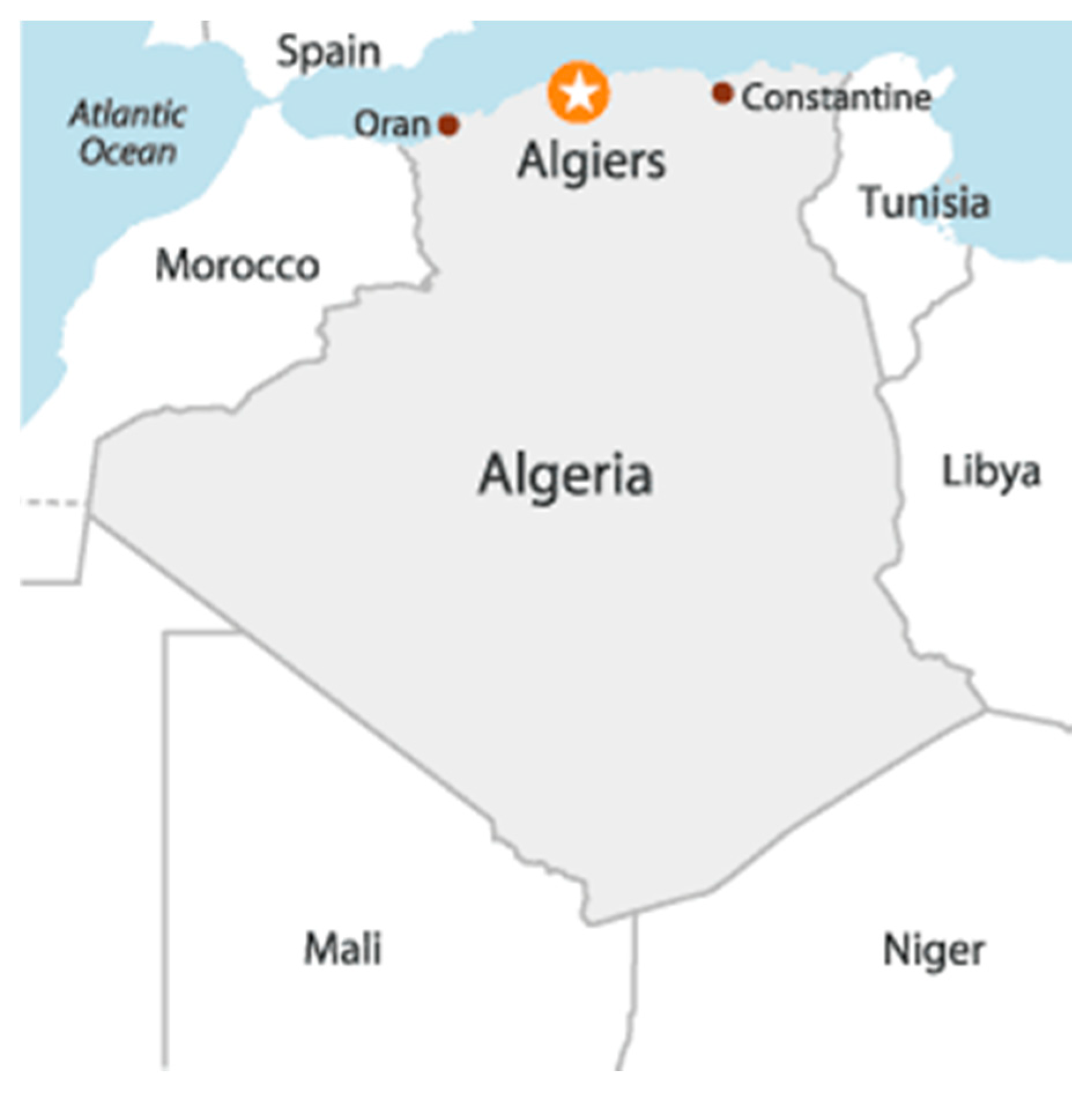

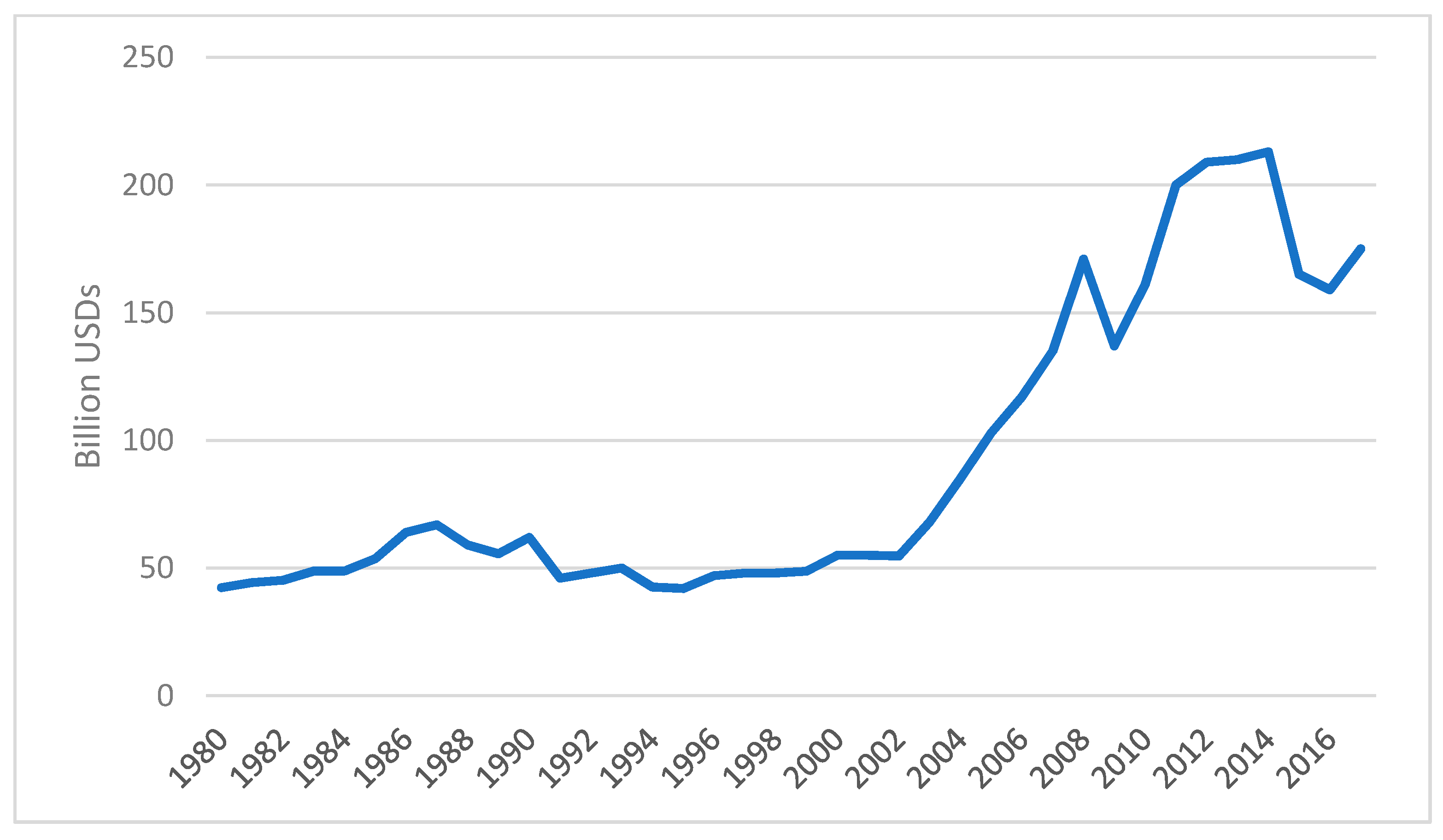
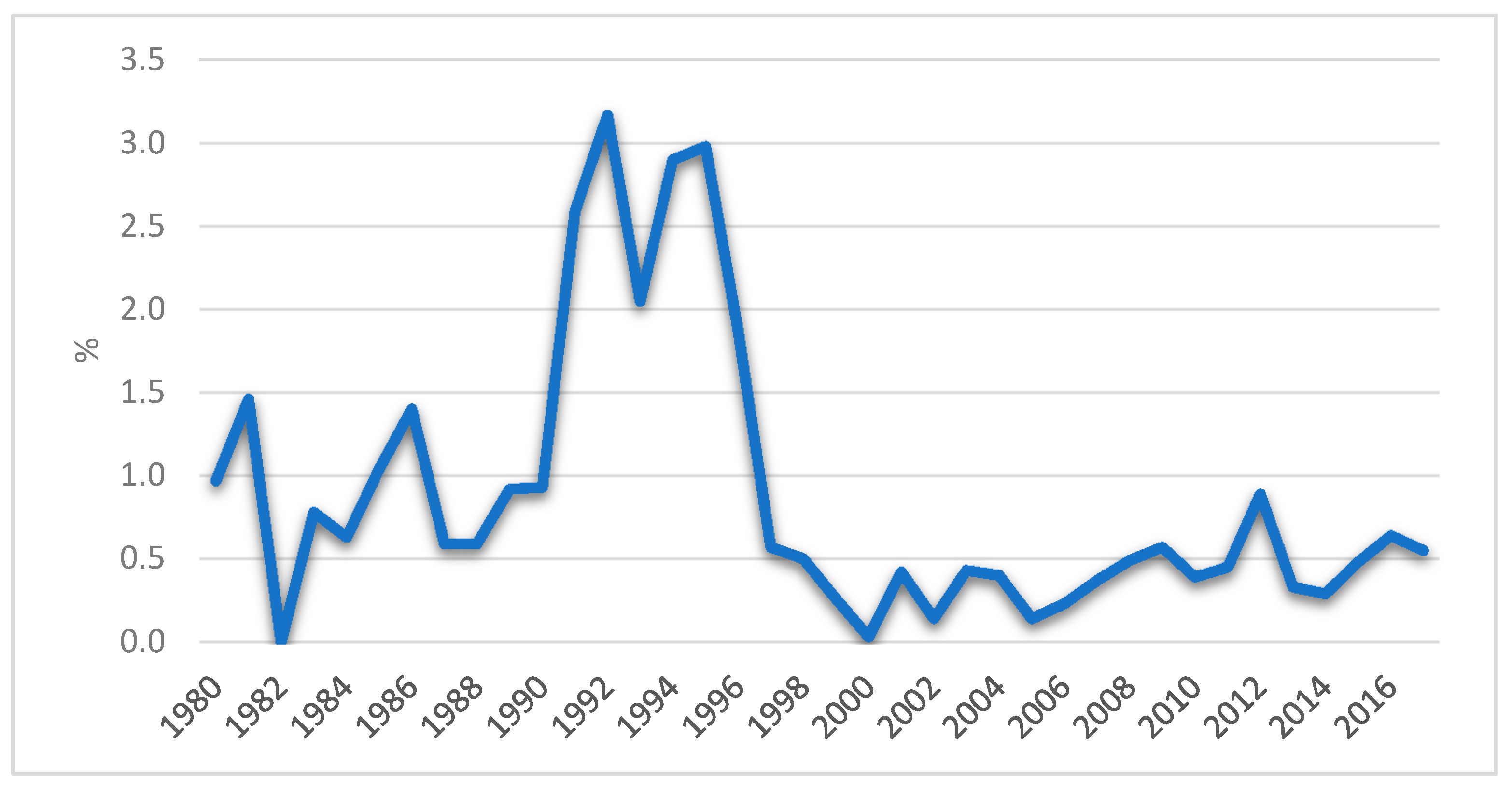

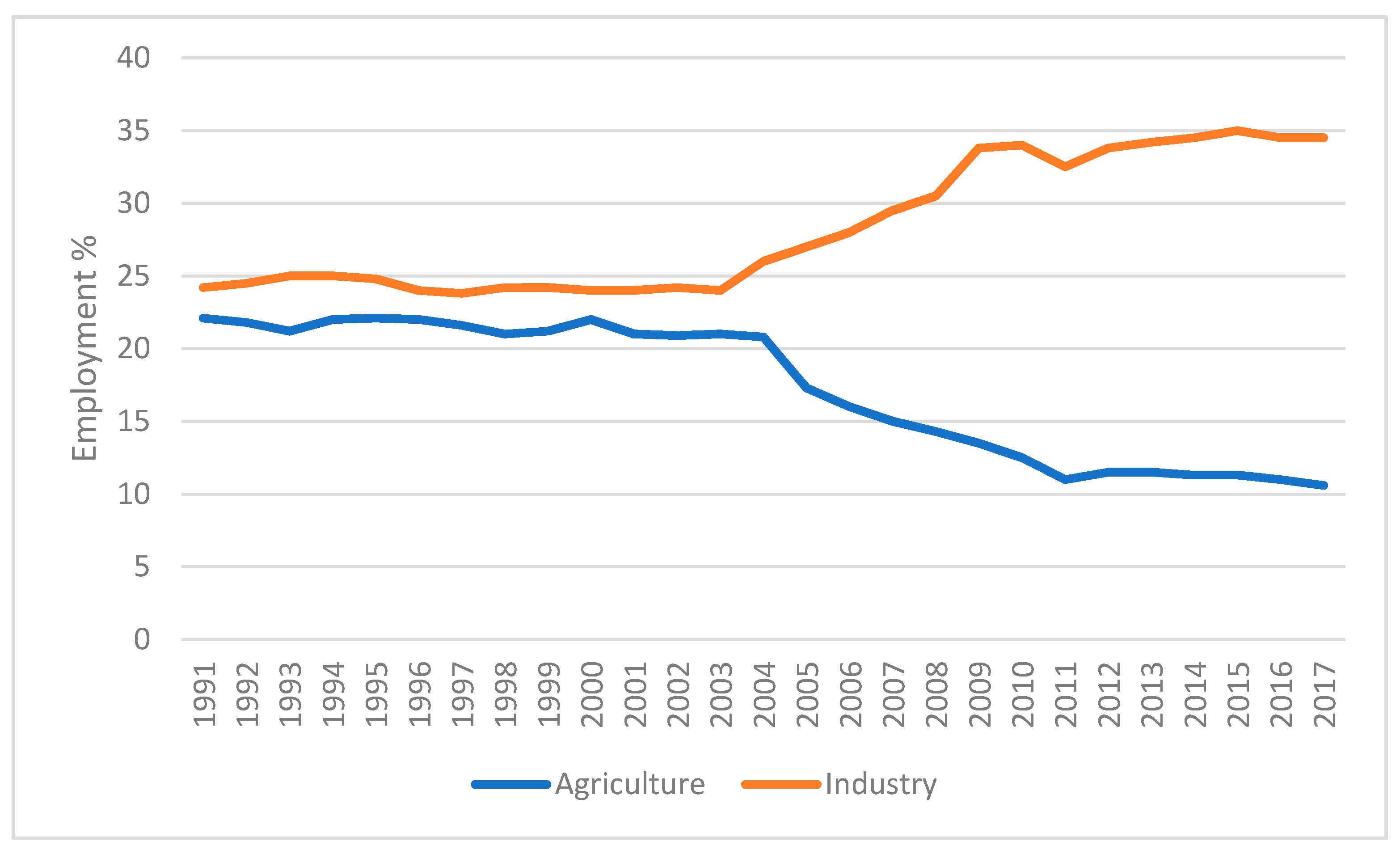
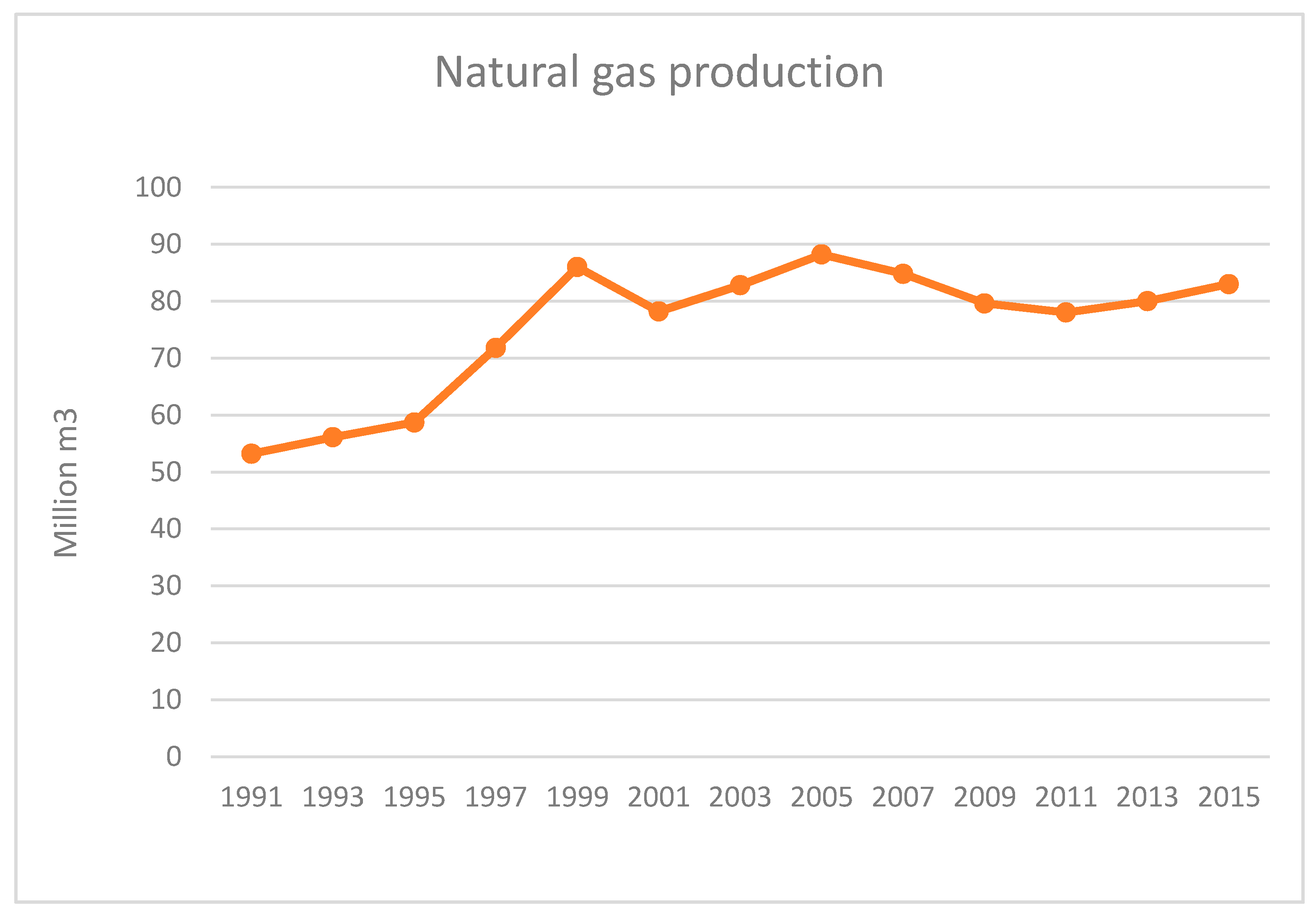

| Project Name | Signed on | Costs Million USD | Completion (Years) | ||
|---|---|---|---|---|---|
| Total | Loan | Scheduled | Actual | ||
| Sewerage works | 1978 | 154 | 82 | 4 | 8 |
| Water Supply Engineering | 1979 | 7 | 5 | 3.5 | 4.5 |
| Algeria-Bas Cheliff Irrigation | 1981 | 13.32 | 8 | 3 | 4 |
| Irrigation Engineering | 1988 | 20 | 14 | 4 | 6 |
| Second National Water Supply and Sewerage | 1988 | 630.5 | 250 | 5 | 8.3 |
| West Mitidja Irrigation | 1990 | 425.9 | 110 | 6 | 7 |
| Sahara Regional Development | 1991 | 94 | 57 | 6 | 7 |
| Pilot Forestry and Watershed Management | 1992 | 37.4 | 25 | 6 | 6 |
| Water Supply and Sewerage Rehabilitation | 1994 | 170 | 110 | 6 | 7 |
| El-Kala National Park & Wetlands Complex Management | 1994 | 11.68 | 9.2 | 3.5 | 4.5 |
| Second Rural Employment Project | 2003 | 142.9 | 95 | 5.5 | 2.1 |
| Project Name | Date | Loan USD | Duration | Countries | Status |
|---|---|---|---|---|---|
| Telemedicine in Remote Areas of Algeria | 2006 | 144,800 | 18 | Algeria, North of Sahara, South of Sahara | Closed 7 months of its proposed end date |
| Political Party Development in the Arab World | 2006 | 344,400 | 30 | Bahrain, Middle East, Algeria, Iraq, Lebanon, Morocco, Yemen, North of Sahara, South of Sahara, Central Asia, Far East Asia, South Asia, Turkey | Closed after 15 months of its proposed end date |
| Sustainable Development of the Algerian Steppe | 2007 | 389,000 | 36 | Algeria, North of Sahara, South of Sahara | Closed on time |
| Water, Health and Climate Change Adaptation in Africa | 2007 | 293,800 | 42 | Burkina Faso, Ivory Coast, Algeria, Egypt, Ghana, Guinea, Morocco, Tunisia, North of Sahara, South of Sahara | Closed after 27 months of its proposed end date |
| Arab Reform Initiative—International Development Research Centre of Canada (IDRC) | 2008 | 581,600 | 24 | Middle East, North of Sahara, South of Sahara, Central Asia, Far East Asia, South Asia, United States | Closed after a month of its proposed end date |
| Exploring Adaptation Scenarios: Cutaneous Leishmaniasis and Climate Change in Algeria | 2009 | 270,700 | 36 | Algeria, North of Sahara, South of Sahara | Closed after 7 months of its proposed end date |
| Information and Communication Technologies for Agricultural Development and Natural Resources Management (MENA) | 2009 | 63,300 | 12 | North of Sahara, South of Sahara, Algeria, Jordan, Lebanon, Morocco, Syria, Tunisia, Egypt, Yemen, Sudan | Closed after 9 months of its proposed end date |
| Management Models of Forest Resources in the Atlas Mountain Chain (North Africa) | 2009 | 685,900 | 36 | North of Sahara, South of Sahara, Algeria, Morocco, Tunisia | Closed after 11 months of its proposed end date |
| Arab Democracy Barometer | 2010 | 589,200 | 24 | Algeria, Iraq, Jordan, Lebanon, Morocco, Egypt, Yemen, Bahrain, Kuwait | Closed after 8 months of its proposed end date |
| Arab youth as political actors: Strengthening resilience through new forms of engagement | 2011 | 417,000 | 24 | Algeria, Lebanon, Syria, Tunisia | Active |
| Governance of Diversity: Case of the Kurdish and Amazigh Communities in the Middle East and North Africa | 494,700 | 24 | Algeria, Egypt, Iran, Iraq, Libya, Morocco, Syria, Tunisia, Turkey | Active | |
| International Crisis Group Quick-Response Research: Addressing Governance and Security | 2011 | 780,000 | 24 | Algeria, Morocco, Tunisia, North of Sahara, South of Sahara, Belgium | Active |
| Translating Genomic Discoveries to Cure Ultrahypermutant Mismatch Repair Deficient Brain Tumours | 2015 | 506,000 | 36 | Algeria, Brazil, Egypt, Jordan, India, Canada, Israel, | Active |
| Project Components | Achievement |
|---|---|
| Water resource development | The construction of the Boukourdane pipeline and the Djer diversion weir had not started or completed on time. |
| Irrigation Expansion | Only 55% of the works were completed. |
| On-farm development | Irrigation equipment were partially delivered. |
| Institutional Strengthening | Surveys and studies had been completed but had not been applied. |
| Studies & Technical assistance | Most of them were cancelled. |
| Training | Training program could not be carried out. |
| Auditing | The audit reports were received but audits of some financial statements were not carried out. |
| Project Components | Achievement |
|---|---|
| Employment creation | 74% and 23% of the TV1 & TV2, respectively |
| Rural income generation | 73% and 18% of the TV1 & TV2, respectively |
| Reforestation | 23% and 15% of the TV1 & TV2, respectively |
| Rainfed Fruit Tree Plantations | 63% and 41% of the TV1 & TV2, respectively |
| Irrigated Fruit Tree Plantations | 37% and 31% of the TV1 & TV2, respectively |
| Vineyards development | 28% and 25% of the TV1 & TV2, respectively |
| Land Improvement | 55% and 34% of the TV1 & TV2, respectively |
| Water Supply (water points) | 46% and 31% of the TV1 & TV2, respectively |
| Water Supply (wells) | 14% and 8% of the TV1 & TV2, respectively |
© 2019 by the authors. Licensee MDPI, Basel, Switzerland. This article is an open access article distributed under the terms and conditions of the Creative Commons Attribution (CC BY) license (http://creativecommons.org/licenses/by/4.0/).
Share and Cite
Mourad, K.A.; Avery, H. The Sustainability of Post-Conflict Development: The Case of Algeria. Sustainability 2019, 11, 3036. https://doi.org/10.3390/su11113036
Mourad KA, Avery H. The Sustainability of Post-Conflict Development: The Case of Algeria. Sustainability. 2019; 11(11):3036. https://doi.org/10.3390/su11113036
Chicago/Turabian StyleMourad, Khaldoon A., and Helen Avery. 2019. "The Sustainability of Post-Conflict Development: The Case of Algeria" Sustainability 11, no. 11: 3036. https://doi.org/10.3390/su11113036
APA StyleMourad, K. A., & Avery, H. (2019). The Sustainability of Post-Conflict Development: The Case of Algeria. Sustainability, 11(11), 3036. https://doi.org/10.3390/su11113036






